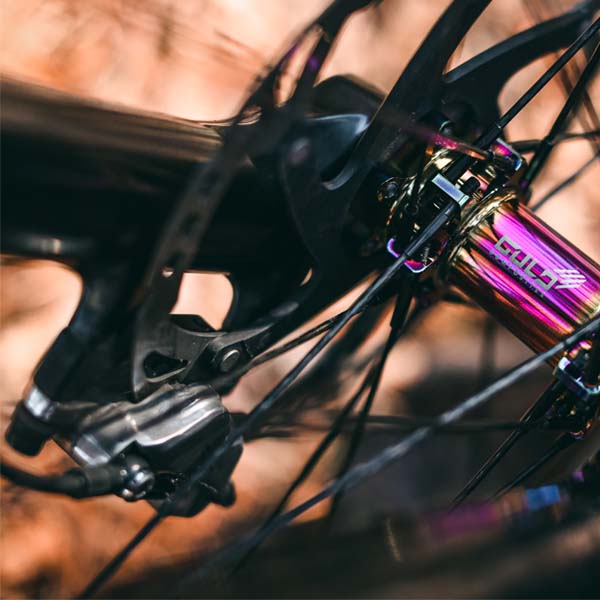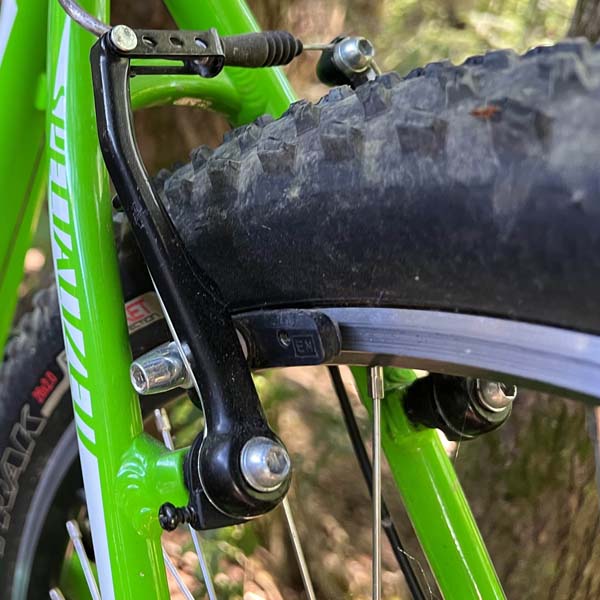Disc brakes vs Rim brakes
We are often asked, “what are the advantages of disc brakes over rim brakes?” and “Does Gulo Composites make a carbon wheel in a rim brake model?” The short answer is no. While there still are many cyclists riding with rim brakes, we decided to only offer disc brake wheels due to the many benefits of disc brakes. But leaving it at a simple “no” didn’t quite leave our readers with an appropriate answer to the first question. In this article, we give a thorough explanation of what the advantages of disc brakes over rim brakes actually are.
The rise of the disc brake
Rim brakes have been the dominant braking system for decades in the cycling industry. Disc brakes started to make inroads in the early 2000s when professional mountain bikers started switching from rim to disc brakes. Professional road cyclists had been slow to convert until recently when disc brakes made their debut at the 2018 Tour de France. Today, most professional teams have converted to disc brakes, with the industry following suit.
How do both disc and rim systems work
First, we need to understand how each braking system works—both slow your bike down by transmitting forces via levers to the calipers. Rim brakes operate mechanically (or cable-actuated) and use levers that connect to cables that connect to the calipers. When the brake lever is squeezed, it pulls on the cable causing the calipers to clamp down on the rim.
Most disc brakes operate hydraulically and use hydraulic fluid and pistons to pressurize the brake system. When the brake lever is pulled, it drives the piston into the master cylinder, which forces the fluid through a hose that connects to the caliper, creating friction that stops the bike.
The Advantages of disc brakes over rim brakes can be broken down into six categories.
- Performance
- Spoke Strength
- Increased Tire Options
- Durability
- Longevity
- Weight
Performance
Disc brakes provide superior stopping power.
Theoretically, it is easier to stop a wheel by clamping down at the end of the radius(rim) rather than at the center of the radius(hub/rotor). With braking, kinetic energy(movement) is transferred into thermal energy(friction/heat). With that said, why do disc brakes perform better in almost all performance tests, including stopping power, modulation, and predictability, especially when riding in wet or muddy conditions?
Stopping power is increased slightly due to increased braking surface on brake rotors which allows for better heat dissipation. Still, caliper travel is the main reason for the superb stopping power of disc brakes. Typical disc brake rotor clearance is about .5mm from the brake pad. Rim brakes have a typical clearance of 3-4mm in the distance from the rim. If the braking caliper has to move a farther distance to initiate friction, the braking power is reduced.
Modulation is defined by the braking power dispersed by pulling the brake lever. With better modulation, the bike rider can more accurately apply an appropriate amount of stopping power by increasing or reducing the pull from the lever. Since the disc brake pads are located closer to the rotor, modulation is increased as well as the braking power. The ability to feather the brake, firmly stop, or completely lock up the wheels is possible by force applied to the lever.
Disc brakes also perform better in wet and muddy conditions due to their compact and shielding design. The central location of the disc brake allows for rain and mud to have less effect on the rotors and calipers. The rim braking surface is located just below the tire, allowing large amounts of mud and water to collect. In contrast, the disc brake rotor is typically designed with grooves to allow mud and water to pass through them and clear out.
Spoke strength is more important for disc brake wheels
Disc brakes cause more stress on the spokes than rim brakes. Wheels using rim brakes, the stopping force is applied very close to the tire at the outer edge of the wheel. With disc brake wheels, the momentum of the rim/tires is slowed down by the brake caliper through the rotor located at the center of the wheel. This adds more stress to the spoke as the energy has to be transmitted through the spoke to slow the wheel down. The extreme tensile strength of our G1 Composite spokes was one of the leading decisions in exclusively using the disc brake system. We designed our spokes to handle the additional stress caused by the transfer of the braking power from the disc brakes to the tire. The combination of the disc brake system and the strength of our wheel system naturally fit together, making for a smoother ride.
Increased Tire Options
On mountain bikes, in the late 90s, rim brakes were still the standard on most people’s off-road bikes. We still remember having to keep the dreaded brake-noodle clean to have that smooth feeling of brake pull. Luckily, mountain bikes were quick to adopt disc brakes and were mainstream by the early 2000s; the constraint on tire width moved from the brake calipers to the frame/fork itself. It didn’t take long for frame/fork manufacturers to retool their designs to be capable of riding larger, wider tires. Disc brakes and disc brake-specific bikes typically open your tire options up significantly. Without having the rim brake caliper surrounding the tire, bike manufacturers can create much more clearance for larger tires. These larger tires offer more traction, air volume, and, ultimately, better performance for the rider.
Durability and product life
Another performance benefit of riding disc brakes is the room for trueness, or untrueness, in your wheels. We all know that stuff happens when you’re out on the trail. You smash a huge rock, hit the landing wrong, or even just a random crash can cause your wheel to come out of true. A popular advantage with disc brakes is if you do hit or crash into an object, you can still ride your bike to get yourself home. A light to moderate hit to your wheels that knocks it out of true can still be ridden. With rim brakes, there is very little room(3-4mm) for the wheels to be untrue, causing brake rubbing, which can make riding the bike home difficult. There is always the option of loosening the brake to allow the rim brake wheel to turn, but then you enter into a new safety issue. When a rim brake wheel gets knocked out of true, this also reduces performance dramatically, as even if the rim doesn’t hit the brake pads while spinning freely, you will still feel the lack of trueness of the wheels when you are braking. Under extreme braking, you would feel the bent rim with every rotation. In contrast, this is an issue avoided with disc brakes, as it is much less common to bend a rotor than a rim while out riding.
If you consider the life of a wheel, it’s important to think about the parts of the wheel that are being used for constant braking and the friction created by that braking. When looking at the rim brake wheel, the friction from the brake load on the rim is causing constant wear to the rim profile. What happens over the lifetime of the wheel is that the braking surface begins to concave, compromising the wheels’ strength and also braking power. With the use of disc brakes, however, bicycle wheels get increased longevity because the braking surface is moved from the rim to the rotor that is attached to the hub. Not only is the rotor replaceable and upgradeable, but the location of the rotor also decreases the amount of mud and debris caught in the caliper. This reduction in debris in the rotor and brake pads also leads to decreased brake pad wear.
Longevity of carbon rims
Another advantage of disc brakes over rim brakes is in rim longevity. Disc brakes have significantly improved the longevity of the rim life of carbon rims. Carbon braking surfaces on the rim not only force the rim design to have a slightly heavier brake tract but also can lead to several issues. There were many instances in the early adopters of carbon rims with carbon braking surfaces with performance and reliability. From a safety perspective, it’s important to consider two key factors. The carbon braking surface requires a special brake pad for rim brakes. Without this special brake pad, the braking performance would be significantly reduced and almost nonexistent in the rain. The second and bigger issue was the rim bead exploding due to excessive heat from heavy braking demands. The carbon brake tract would heat up and fail if enough friction was applied through breaking. This left riders on the side of the road with an exploded tire and no way to repair it. This catastrophic failure was fairly rare but significant nonetheless.
Weight advantages
The net weight increase from disc brakes vs. rim brakes on your bike can be upwards of 450 grams. The lightweight features of our wheels largely negate the typical weight gain on your bike. Also, it’s important to consider the disc brake-specific rim doesn’t require as much carbon material at the end of the rim where the rim brake surface would typically be. This results in a lighter rim at the end of the rim radius. This gives exponential rotation weight savings because it is the part of the rim that requires the most power to accelerate up to speed. The increased weight of the brake rotor is located much closer to the hub, which reduces the rotation weight. While the weight is increased slightly with the rotor, the rotation weight is typically decreased.
John Murphy
Ex Professional road racer
As a bike racer for the better part of 30 years, I have seen the evolution of rim-to-disc brakes on the mountain bike and road. I have always supported disc brakes for road bikes. For me, hydraulic disc brakes were always a no-brainer as the increased stopping power, especially in the wet, was a huge incentive. I have had several encounters with my brakes failing in the rain, which is very scary. I also prefer the stiffness of thru axles that are typically associated with disc brakes. As a sprinter, stiffness and braking power were always more important than the lightest setup. And if you add in the amazing brake feel of hydraulic brakes, disc brakes are a clear winner in my book.





